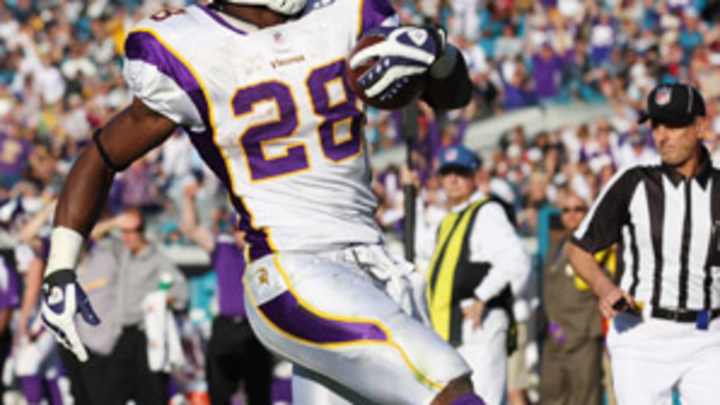Pound-foolish?


This article appears in the May 18, 2009 issue of Sports Illustrated.
With Minnesota's Brett (I Want You to Want Me) Favre flirtation on hold, the Vikings can move on to more serious issues, such as All-Pro running back Adrian Peterson's desire to get bigger for 2009. The 6' 1", 218-pound Peterson, who led the NFL in rushing with 1,760 yards last year, already has a comic-book physique and a handshake that could make diamonds out of coal, but he wants add 10 to 12 pounds by training camp. "I don't think too many guys would be excited to see me at 230 two times a year," he said at the Pro Bowl in February and recently reiterated the desire.
Not everyone thinks it's the right move. Coach Brad Childress has expressed concern over how the added weight would affect Peterson's speed and agility. Some fellow ballcarriers also believe bulking up is a bad idea. "You think you're going to be more durable, but injuries are still going to be there because of his [physical] running style," says former Saints back Deuce McAllister. "You say 10, 12 pounds is going to enable you to punish defenses, but the reward is not worth the risk."
McAllister played at about 220 as a rookie in 2001, then started putting on weight for the rigors of a full-time role after Ricky Williams was traded to Miami in '02. In '05 and '07 McAllister, who weighed 232 by then, sustained ACL tears without being hit. "I believe if I hadn't put on the weight, it wouldn't have happened," he says.
Indeed, there's even an argument for slimming down. LaDainian Tomlinson says he weighed as much as 225 in college but has stayed between 214 and 218 since being drafted by the Chargers in 2001. "There's no way you can't lose some of your quickness if you put on weight like that, even if it's muscle mass," he says. "In my best season [2006, when he led the league with 1,815 yards and 28 rushing TDs], I was 214 pounds, the lightest I've been in my career."
Peterson has missed two games to injury in his two seasons. While elusive, he doesn't shy from contact, and that style in a heavier frame could be risky. "Imagine we have a backpack, and we put 20 pounds in it and start going up and down stairs," says Bubba Wilson, a certified athletic trainer who has worked with NFL players. "That's a pretty significant stress on your knees by itself. If we add the cutting, jumping and twisting that you get with being a running back, it really magnifies it."
Clinton Portis offers another case study in bulking up. As a Broncos rookie in 2002 he played at 192 pounds. Two years later he was traded to the Redskins, in the rugged NFC East, and began adding weight to absorb extra punishment, topping out at 226. In D.C., Portis has had only one season in which he missed significant time to injury (a bad shoulder and a broken hand in '06), but he admits to having sacrificed breakaway speed. He had seven runs of 50 or more yards in two seasons with the Broncos but has had only one in five years with the Skins -- on his first carry for the franchise. "You have trade-offs," says Portis.
If Peterson sticks to his plan, he could find that out for himself.
